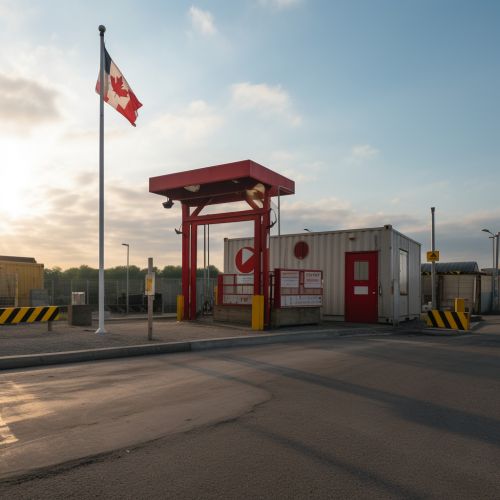Borders
Definition and Concept
A border is a geographical boundary that separates political entities such as nations, states, provinces, or territories. It is a physical or conceptual line that delineates areas of jurisdiction or property rights. Borders are established through agreements between political or social entities that control those areas; the creation of these agreements is called boundary delimitation.
History of Borders
The concept of borders has evolved over time, with the development of societies and political systems. In ancient times, borders were often natural features such as rivers, mountains, or forests. With the rise of city-states and later nations, borders became more defined, often marked by walls, fences, or other physical structures. The Great Wall of China and the Hadrian's Wall in England are examples of such early borders.
Types of Borders
There are several types of borders, including:
Natural Borders
Natural borders are formed by physical features such as rivers, mountains, oceans, or deserts. These borders are often difficult to cross and can serve as effective barriers to movement. An example of a natural border is the Himalayas between India and China.
Political Borders
Political borders are artificial lines drawn on maps to separate different political entities such as countries, states, or provinces. These borders are often the result of historical events, treaties, or negotiations. The 38th parallel north which divides North and South Korea is an example of a political border.
Economic Borders
Economic borders separate regions with different economic systems or levels of development. These borders can be physical, such as a wall or fence, or they can be conceptual, such as a tariff or trade barrier. The Iron Curtain that separated the capitalist West from the communist East during the Cold War is an example of an economic border.
Border Control and Management
Borders are not just lines on a map, but are actively managed and controlled by the entities they separate. This control can take many forms, from physical barriers and checkpoints to legal regulations and policies.
Physical Barriers
Physical barriers, such as walls, fences, and guard posts, are used to prevent unauthorized crossing of borders. These barriers are often accompanied by surveillance systems and patrols. The Berlin Wall was a notable example of a physical barrier.
Legal Regulations
Legal regulations govern who can cross a border and under what circumstances. These regulations can include visa requirements, customs inspections, and immigration controls. The Schengen Agreement in Europe, which allows for free movement across many European borders, is an example of legal regulation of borders.
Border Disputes
Disputes over borders can lead to conflict and tension between countries. These disputes can arise due to historical disagreements, resource claims, or geopolitical strategies. The Kashmir conflict between India and Pakistan is an example of a border dispute.
Impact of Borders
Borders have a significant impact on the areas they separate. They can affect trade, migration, security, and cultural exchange.
Trade
Borders can facilitate or hinder trade between countries. Tariffs, quotas, and other trade barriers can impact the flow of goods across borders. The North American Free Trade Agreement (NAFTA), which reduced trade barriers between the United States, Canada, and Mexico, is an example of how borders can impact trade.
Migration
Borders control the movement of people between countries. Immigration policies and border controls can determine who can enter a country and under what conditions. The Mediterranean migration crisis is an example of how borders can impact migration.
Security
Borders are crucial for national security. They can protect a country from external threats and maintain internal stability. The demilitarized zone (DMZ) between North and South Korea is an example of a border used for security purposes.
Cultural Exchange
Borders can also influence cultural exchange. They can separate different cultural, linguistic, or ethnic groups, or they can serve as meeting points where different cultures interact and influence each other. The U.S.-Mexico border is an example of a border that has influenced cultural exchange.
Future of Borders
The concept of borders is constantly evolving. With the rise of globalization and digital technology, the significance and function of borders are changing. Some argue that borders are becoming less relevant as people, goods, and information move more freely around the world. Others argue that borders are becoming more important as countries seek to control these flows and assert their sovereignty.
See Also
- Boundary delimitation
- Great Wall of China
- Hadrian's Wall
- Himalayas
- 38th parallel north
- Iron Curtain
- Berlin Wall
- Schengen Agreement
- Kashmir conflict
- North American Free Trade Agreement
- Mediterranean migration crisis
- U.S.-Mexico border


